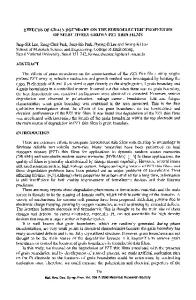Effects of dopants in PZT films
- PDF / 10,199,717 Bytes
- 15 Pages / 576 x 792 pts Page_size
- 50 Downloads / 334 Views
Undoped and lanthanide (La and Nd) doped P b ^ T i ^ ^ , i.e., PZT, ferroelectric thin films were prepared by metallorganic decomposition (MOD) and spin-coating. The precursors for making the undoped PZT films were derived from lead acetate, zirconium n-propoxide, and titanium isopropoxide. In addition, lanthanum acetylacetonate and neodymium acetate were introduced into the precursor solution to accomplish the doping of the corresponding elements. Both undoped and doped PZT films were coated onto Pt/Ti/SiO 2 /Si and single-crystal sapphire substrates to various thicknesses and annealed at a range of temperatures and times. The effects of lanthanide dopants in PZT films were studied with regard to microstructure, Curie temperatures, crystal distortion, optical properties, and electrical properties. The results indicate that the addition of La and Nd dopants tends to enhance perovskite phase formation and improve the packing densities and electrical properties of PZT films.
I. INTRODUCTION Lead zirconate titanate (PZT) thin films have been extensively investigated for nonvolatile memory device applications due to their remarkable ferroelectric properties. The compositions near the morphotropic boundary (MPB), with a Zr/Ti ratio of 53/47, are especially important because most of the interesting properties are optimized along it; close to the MPB, there is an increase in the dielectric constant and remanent polarization, and reduction in the coercive field. The reported techniques to deposit PZT thin films include evaporation,1 sputtering,2 laser ablation,3 pulsed laser deposition,4 metallorganic chemical vapor deposition (MOCVD),5 sol-gel process,6 and metallorganic deposition (MOD).7 Of all the deposition methods proposed, MOD is one of the simplest techniques available to prepare pure stoichiometric thin films of multicomponent oxides. The MOD process consists of the following steps: preparation of the metallorganic precursor solution, spin or dip-coating onto a substrate, removal of the solvent, pyrolysis, and crystallization of the films. The precursor solution used for the MOD process is prepared by dissolving metallorganic compounds in a suitable organic solvent. Since the starting materials are mixed at the molecular level, higher levels of compositional homogeneity can be obtained from this technique. Additionally, dopant elements, which are important in adjusting the microstructure or improving the properties of the materials, can be easily introduced into the solution by adding the corresponding metallorganic compounds. a)
Author to whom all correspondence should be addressed. J. Mater. Res., Vol. 9, No. 4, Apr 1994 http://journals.cambridge.org
Downloaded: 17 Mar 2015
Furthermore, the films prepared by the MOD process have displayed ferroelectric and optical properties comparable to those of bulk ceramics.8 Although PZT thin films fabricated by MOD are of considerable interest due to the short processing cycle, very little has been investigated regarding the effect of dopants on PZT film properties. Fo
Data Loading...











